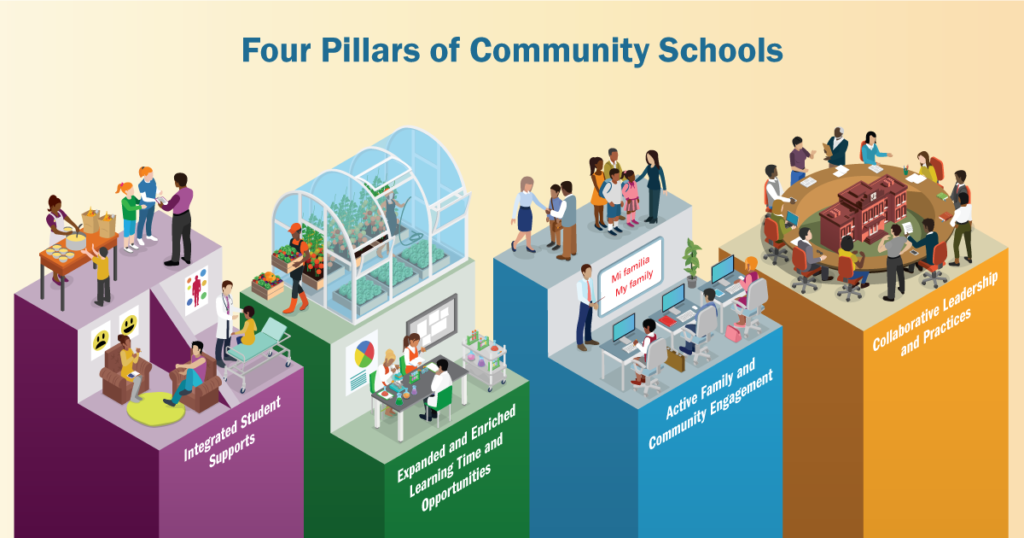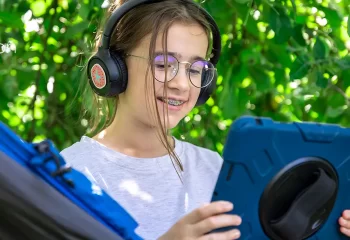Community Schools Fundamentals
“Community schools are grounded in the principle that all students, families, and communities benefit from strong connections between educators and local resources, supports, and people.”
According to the Coalition of the Community Schools, they are “both a place and a set of partnerships between the school and other community resources, [with an] integrated focus on academics, health and social services, youth and community development, and community engagement.” (Coalition for Community Schools)
What do students need? Students need an environment of care where intellectual, physical, mental and emotional development are core.
History of Community Schools
The community schools model date for many years now. And today, they strive to be better and become a place where people are given the chance of belonging and the opportunity to interact with a community that understands them.
The idea behind the community school model is that the school environment is the perfect place for a social centre where the needs of people from the community are listened to.
Many community schools came as a response to poverty and inequality, especially in the 20th century when the social and civic needs were not attended to correctly, and few people had access to a good education program.
“Community schools have a long history of connecting children and families to resources, opportunities, and supports that foster healthy development and help offset the harms of poverty” (A Review of the Evidence).
How Do We Know Community Schools Work?
What does it mean to be a part of a community school? A community school is a primary liaison for the community that is a part of it. It offers academic and non-academic help for both students and their families.
Why do this? Being a part of a school community engages students and helps them focus on studying more and more; it also allows teachers to focus on teaching rather than solving other students’ issues.
Poverty and isolation make it difficult for schools to offer good education to their students. This type of community school does not make a difference between different social classes and different students – they believe each should have an equal opportunity to succeed and offer the same quality of education and attention one can use to succeed in life.
The principal of such a school needs to prioritise the well-being of both students and teachers. A need to measure their performance exists, and a good principal does this and recommends improvement actions.
How are community Schools funded?
The community’s schools have various environments where they operate. Still, there are four main pillars they all focus on:
– Integrated student support – which is the foundation of each community school
– Expanded learning time and opportunities
– Family and community engagement
– Collaborative leadership and practice.
Figure 1. Community Schools as an Effective School Improvement Strategy
The idea behind community schools is to offer students an environment to learn and develop beautifully. They cover all the student’s needs starting from academics to well-being. It is an educational model that creates an environment that prioritises high-quality learning.
Importance of school and community relationships (link to cluster)
What does a community school support?
A community school believes that the strong ties between the student, family, the community and the school is essential to reach the academic goals we wish for. Making this a real point takes time and effort, but involving students and their parents in this process is a plus and helps students and families be engaged community members.
Community Schools in Practice
Examples of community involvement in schools (link to cluster)
Community involvement in schools is all about letting the family and other members of the community have a specific power in the decision making in the school. More than just being a part of the changes that take place in the school, parents are directly involved in the school actions that their children have and even take part in some lessons to broaden their knowledge.
Community involvement in school comprises more than just parents’ involvement – all the members of the family are accepted to be a part of the community.
Community involvement in action can be
– Participating in the school programs of their children
– Receiving educational opportunities
– Teaching other parents
– Engaging new families with the program
– Participating in school meetings
Parent involvement in school activities (link to cluster)
Through the involvement of parents in school activities, community schools show students that school is essential and that the learning process begins at an early age and continues throughout their lives.
It is important that parents are involved in their children’s school learning process as it has been proven that this involvement is directly connected to the success they have academically. While some parents may need to get some training to be able to use the learning materials wisely, there is no shame in that. The involvement is what matters at the end of the day.
Such parent involvement activities are
– Parents reading with their children
– Parents communicate with the school directly regarding the learning challenges and the progress their children make
There is a direct connection between parents’ involvement in school activities and students’ involvement in school. Taking after their parents, children tend to have a bigger engagement rate when they see the interest their parents have in school activities.
Community engagement activities for students
Through community engagement activities students have the chance to see the real effect they can have on the world. They will see that each helping hand is welcome and they are learning to contribute to a better world. They realise that this starts with them and their willingness to engage in community activities.
Some community activities students can participate in are:
– Help choose school extracurricular activities
– Join different clubs that create a more significant connection between students
– Openness to new activities
– Support a particular group – such as clean-up, local environmental activities
– Collaborate with students from the community to take actions that are needed for healthy student life, a healthy environment, children and people’s wellbeing.
Four Pillars of Community Schools
There is a big resemblance between the community schools and the high-quality schools that come at a higher price. These four pillars below of community schools are the characteristics each high-quality school needs to have in order to perform and be accepted as a high-quality school.
Student Support
With the student support pillar, community schools intend to answer all the social and emotional experiences their students live. This is why a lot of them partner with experienced professionals that can deliver good results as far as communicating with their students when there is a need for conflict resolution, trauma after a bullying experience, mental health and social-emotional learning.
Student support means everything from human and health support services addressing the social and economic challenges facing disadvantaged youth – to counselling, on-site child care, child nutrition, and transportation.
We strongly believe as a private school that all students need to be cared for and supported as the school is the main environment where they learn and socialize. If there is no support in helping them overcome the challenges that may appear along the day, their development might suffer.
Learning Time and Opportunities
While each school has some mandatory programs that students have to follow, these school communities provide the opportunity to select various other extracurricular activities. These help students get engaged in real-world problems, follow their passions, relax and communicate in a more informal environment than that of the school.
Community Engagement
A great way to engage parents in the decision-making process as far as their children’s education is concerned. Parents from different backgrounds are able to share the needs their children have and their expectations when it comes to education. Moreover, they can form different classes and community channels that can help build relations with other parents from the community. It is a great help when you have community support that you can go to. Moreover, for those parents that need to develop their skills, there are even opportunities to learn – computer classes, STEM etc.
Moreover, through simple community engagement, students feel like their families are directly involved in their learning process, and they make more positive academic outcomes; their families have also access to solutions for their housing, food and financial problems and overall the family is more united.
To be able to build long-lasting relationships through the community, many schools choose to have two-way culturally and linguistically communication between schools and parents.
Leadership and Practices
There is always a need for improvement and each strategy comes with something new to add to the education process. When there is a shared responsibility for the school development, between the teachers that are in direct contact with the students, the community, and the school coordinator, good practices will always have good results.
Some schools involve the family in their leadership decisions this is why some may have family and community members inside their leadership team. With the help of all, they plan and oversee the good development of the school and their response to children’s needs.
Community school vs public school (link to cluster)
Main Differences
| Community school | Public school |
| Integrate full social and health services | Access to public services |
| Extended learning opportunities | Curriculum that is accepted by the district office |
| Onsite coordinator to discuss with parents and families what is important and what is needed for their children | Teachers are the only ones available |
| Children from all districts can enrol | Only children that live in the district if the school can enrol |
| Wide curriculum that differs and is flexible | Regulated public curriculum that all public schools offer |
Which one is the right one for you?
The right school for a person is the school that ticks the most of your needs.
While a public school is there for large public and you can grow and learn a lot of things, there is the need to be able to understand the difference between what is bad and what is good, what you can learn from each experience and what you can copy. In public schools usually, children don’t always have access to professional help whenever they need it, they do not feel so relaxed about opening up and discussing and they sometimes may feel like there is not enough time given to their needs. The truth is most public schools do not have enough personnel to answer the needs of each child and children may tend to close up.
But here comes the private schools. They are known for being there for each student, being able to understand their needs and offering professional support whenever they need it. For many years children have been raised as keeping things to themselves, not speaking up, not asking questions and being left in the darkness. However, children need to be heard and understood and more emotional children need bigger attention from their educators. As parents tend to have a busy life and usually see the children just a few hours a day, some children may feel at a loss if they don’t really have an environment where they can express their feelings. And I believe this is what private schools are very good at – caring for the well-being of students.
It is very important to focus on their well-being as this affects their school performance as well.
While parents try to tick this box at home as well and more than just try, there is a must for them to care for the wellbeing of their children, school is just as important as an environment as the home one. Fostering an educational environment where well-being is important is essential for today’s children.
And mind I say that public schools try their best to do this also. But their problem is not the lack of will, but the lack of personnel and capacity. With this in mind, I believe if we work together as a community public schools where most children have access, can be improved in answering these needs.
Conclusion
Community schools are great proof that the four pillars they have work for the benefit of the students and their families. If a few of the strategies community schools have in place would be taken on by the public schools, educational practices would be improved and the academic success and the well-being of the students would increase.
Community School Model FAQ
What are the four pillars of community schools?
The four pillars that the community schools are based on are
– The student support
– The learning time and opportunities
– Community engagement
– Leadership and practices
What makes a good community school?
A good community school has the student’s best interest at heart and makes sure the students are offered the full support they need, in any regard. It does not take into account the social background and offers poorer children the same opportunities as those offered to their wealthier peers. (Turner, A. et al., Vibrant Neighborhoods, Successful Schools, 2009)
What are the three key features of a community school?
The four pillars of the school community are still important. However, developing from them, there are some key features of a community school:
– Support for families and their children
– The connection between different social environments
– A flexible and wide curricula for students
– Various extracurricular activities
How can a community school empower students and their families?
A community school does not only enable students for greater academic achievement but also helps create a stronger connection between students and their families.




